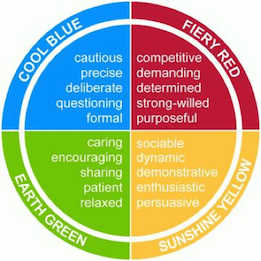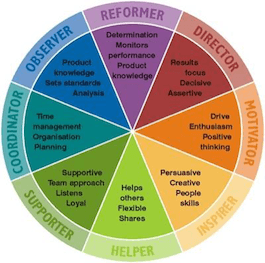We are all individuals - our experiences and personality affect who we are and how we see the world. We all learn in different ways and grasp concepts at different rates. Some of us need to fully understand how a piece of technology works before implementing / using it, while others can just run with a basic understanding. Knowing this, why do we sometimes assume each of us work and learn in the same way as ourselves? Here are a few techniques on getting the best out of your team by understanding each of your roles, creating a safe environment, and transforming your workforce so that you can all grow and learn from each experience.
I don’t see colour, but people tell me I’m YELLOW.
In any environment it is essential to know how you are perceived. It is also important to understand the motivations of each of your team members in a workplace. I have found, colour personality profiling, determining a person’s personality type based on the work of Carl Jung, really useful to identify the types of people in my teams. Jung uses colour energies to identify the four basic personality types.

He explains that each person will exhibit tendencies of each colour to differing degrees at different points, which is why the four personality types can be split further into eight different behavioural types. What we can take away from this and apply to our teams, is knowing how to spot the dominant colour within ourselves and each other to best manage interactions and build on relationships. Colour personality profiling can help each team member to understand theirs and others role and the contribution they play in helping the team succeed.

In my opinion, the best way to find out someone’s colour profile is in group environment. You will be able to spot the more introverted, reserved individuals whose primary focus may be problem solving and wanting to be correct. Versus the extroverts within your team who are motivated by the company of others and can easily influence those that they interact with. Knowing this, it is no wonder then that strongly orientated extraverts and introverts see things in different ways, which can cause conflict and misunderstanding. Two people may look at the same situation and yet see different things. One team member may be able to thrive better by bouncing ideas off the group, while the cool blues among us may do better when you give them a quiet minute to properly think through their ideas before presenting them to others.
Now, I’m not saying go ahead and learn each percentage of colours of each team member, but what I am suggesting is to try and pull out their dominant colour so that you can get a better gauge of who they are and their motivations, so that you can be adaptive in your approach when communicating with them. Colour profiling will help you work to your team strengths and motivate your team in such a way they feel more driven.
Experiment with ideas… #YOLO
Don’t let the fear of being wrong rule the day. For new ideas to be adopted, we need to make room for experimentation and a trial and error approach. Experimenting with new ideas can lead to new ways of solving problems. Nobody wants to work in a toxic environment where they fear taking risks because of the consequences that may follow. As leaders we need to make sure that the environment which we create for our workforce is one where our team is comfortable being uncomfortable. Let them take a risk, let them change the game; there are no repercussions for getting things wrong just as long as you have learnt from it. Healthy discomfort comes from pushing the envelope on new approaches, while managing and monitoring risks and learning in the process.
Enabling experimentation brings out creativity. Once a problem or a new idea have been encountered, give your team the confidence and incentive to solve it until problem solving just becomes another part of your agile culture. One way of finding time to experiment on new ideas and solving problems is by having your core team working towards your everyday goal, while a few others are experimenting with the new idea /problem. Not all experiments will lead to a breakthrough, and this is still a good thing as you will be able to make a valid decision based on the outcome. Successful innovation is all about making decisions based on data-driven insights gained from experimentation and trials.
Hi, my name is Shana and I have failed.
When it come to the end of a project / delivery one of the things I have learned is to always have a wash-up session where you cover all the lessons learned. This is an ideal way to go over the highlights and lowlights which has occurred. It also gives you time to reflect as a team, so you can appreciate what your team do well, and what areas you may need to work on. One of the most valuable activities I have come across in a wash-up is a Failure SwapShop. This is where each team member comes to the wash-up with one failure. This could be something small as not asking for help when they needed it, to missing a deadline due to bugs in their code. The idea is you go around the room taking it in turn to explain your failure, then (but most importantly) the lesson(s) learned from it.
So something like this…
-
Introduction
Hi, my name is Shana, and I have failed. Group Acknowledgement – Cheers and claps -
Explain the failure
I failed because I did not put enough effort into testing my bug fixes before merging it in with the master branch. -
Explain the lesson learned
I have learned that I should spend more time in testing my branch before requesting a merge, as it only slows down the process. I have also learned that fixing one issue may have a knock on effect on to the rest of the application, so don’t just test the fix, try to test everything associated with it. Group Acknowledgement – Cheers and claps
The main idea here is that everyone shares and reflects on their failure in a safe way and each lesson learnt is celebrated with a round of applause – because we are all learning from our mistakes. I find this to be an effective technique to acknowledge and grow from failures as a team. We can learn from others experiences. As they say; a smart person learns from their mistakes and a wise person learns from the mistakes of others.
At the end of the day, true failure is when you have failed and don’t learn your lesson. So create a culture where sharing information, even about negative things, is desirable. Where failing will have a positive effect on the growth and culture of your team.